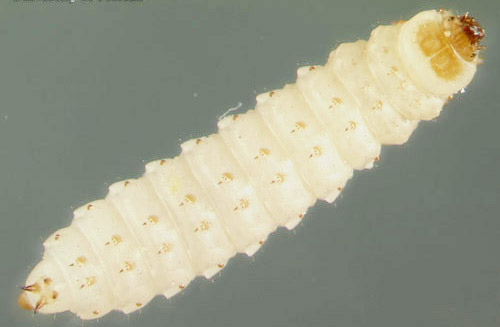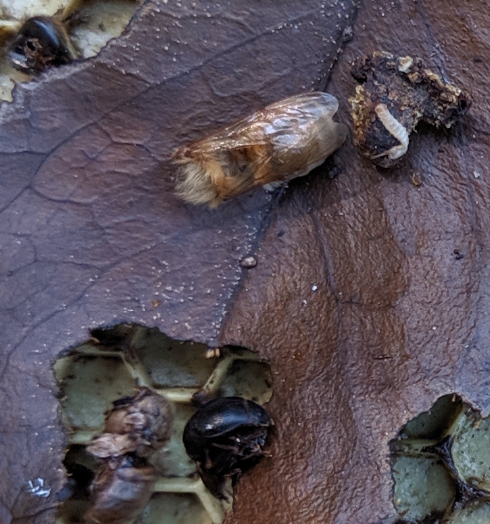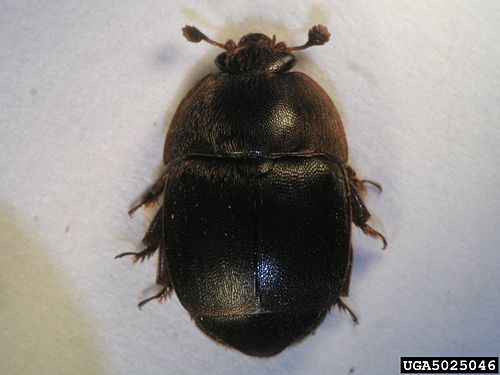Recently, and very sadly, one of our hives absconded, we think due to hive beetles. Absconding means the whole hive leaves. Swarming usually involves smaller numbers of bees, with one queen, departing, leaving some remaining bees behind, perhaps with a second queen, or about to make a new queen.
The only good news about a hive absconding is that you know the hive flew off. There are few or no dead bees left behind, or outside the hive, as you’d discover if a hive was poisoned by pesticides, or succumbed to Varroa mites, or attack from another hive.
Absconding usually means the bees were finding it hard to live in the hive for some reason. The important thing is to figure out what the reason was. I had been down at the hives and noticed almost no bees going in and out of hive 3. Just the week or two before it had been thriving. I did find one dead bee right at the entrance. The hive felt cold to the outside touch and there was no lovely humming sound coming from the hive. Nervously, I opened the hive – and discovered it empty of bees. I noticed something I’d never seen in one of my hives before – a black beetle walking on the inside of the hive. Upon closer inspection, there were a good number of these beetles on the lower part of the hive where the brood were. As we pulled out the frames, one by one, we were shocked to see all the honey gone. Well, at least that might mean that the honeybees gorged and filled themselves up with their honey to take it with them.



We also noticed not much brood and some capped brood prematurely uncapped. Upon reading, we learned that hive beetles feed on honeybee larva and honey. If the number of beetles gets too large, it weakens the hive by making the bees work harder than ever and not gain any ground as their honey and next generation of offspring get eaten by the beetles.
To kill the bees in the hives, we installed super easy to use and effective bee blaster strips on top of the hive between frames. We filled with vegetable oil (to drown the beetles).
We also put a neat little trap on the bottom of the hive to kill any down there (the beetles go to these two places often so you can kill them when they’re there). They are thin black plastic containers. You open them up, put a little honey and boric acid in the middle. The honey attracts the beetle and the boric acid kills them. Only the beetles can get in the holes, which are too small for the bees. You check the traps periodically and discard the dead beetles.
To be sure the hive beetles didn’t return to the area where we keep our hives, or live underneath the hives, it’s recommended to put a layer of gravel or rocks on the ground under the hive. We also distributed two types of beneficial nematodes under and around the hive and in all the greenery nearby.
This beneficial nematode, called Steinernema riobrave, is specifically good at eating hive beetles like the ones we had in our hive. We wish we’d been using the nematodes earlier before we lost our hive!
From the arbico-organics website: Steinernema riobrave are naturally occurring, soil dwelling ambush predators that control a wide range of turf and citrus pests including armyworms, black cutworms, citrus weevils and Japanese Beetle grubs. They are also significantly more effective for treatment of subterranean termites than some of their counterparts. Similar to other nematode species, S. riobrave release a bacteria once they have infected the pest. This bacteria slows feeding and kills the pest within 24-48 hours of infection. The beneficial nematodes will continue to reproduce inside their host after death and emerge ready to infect other hosts. Best yet, you can release these nematodes around your vegetables, fruit trees, and other consumable crops, and near your pets or livestock…even indoors. They are safe.
Here’s the link to where we bought our supply. We actually used NemaSeek and NemaAttack https://www.arbico-organics.com/product/beneficial-nematodes-steinernema-riobrave This is what the contents look like. It’s pretty easy to use. All you need to add is water. You need a strainer to remove the gel after you add water and agitate to activate the nematodes before you distribute them. If you have a sprayer, that’s the best way to apply them.

